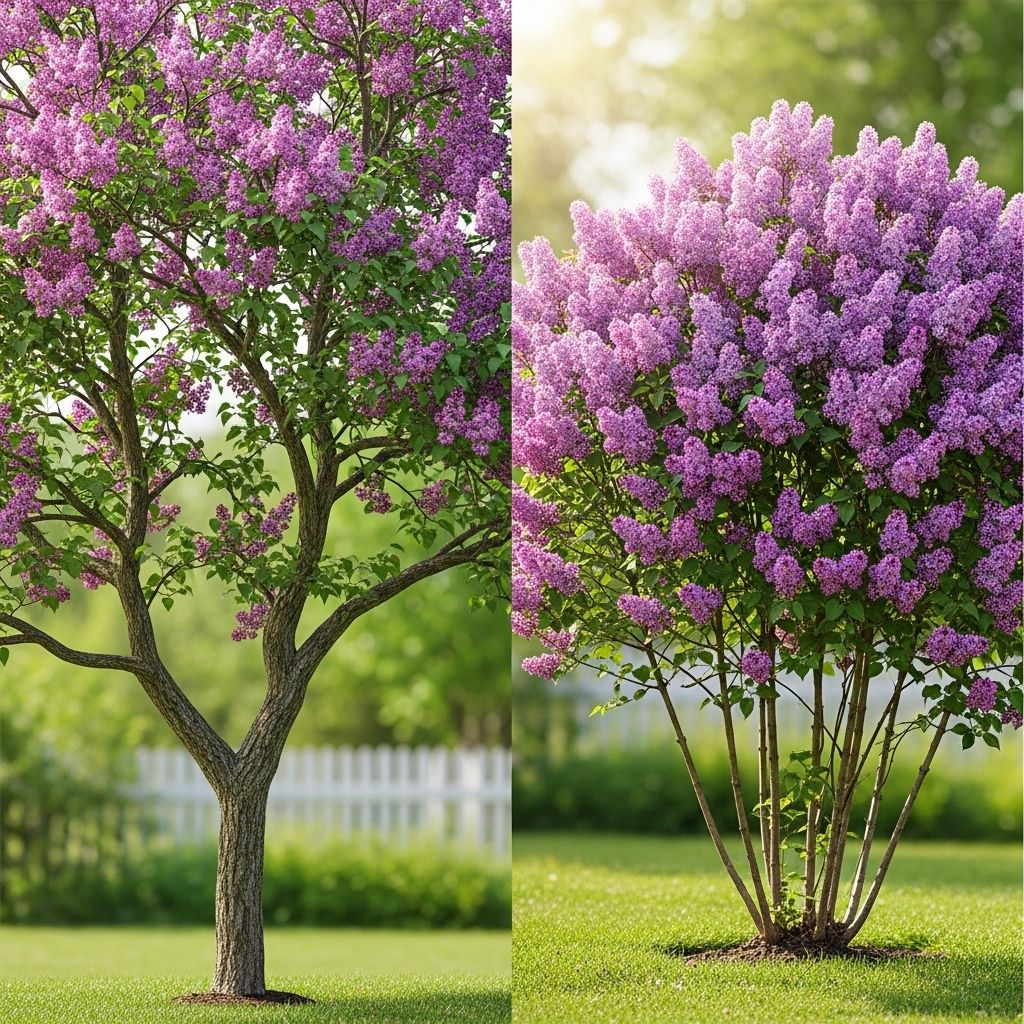Lilac Tree Vs Shrub: 5 Key Differences For Your Garden
Uncover the unique characteristics, growth habits, and care tips for lilac trees and shrubs to transform your garden into a fragrant paradise.

Image: HearthJunction Design Team
Lilac Trees vs. Lilac Shrubs: What’s the Difference?
Lilacs are iconic spring bloomers, celebrated for their sweet fragrance and colorful displays. But gardeners often find themselves asking: what is the difference between a lilac tree and a lilac shrub? Understanding these distinctions is essential for selecting the best fit for your garden and ensuring optimal care.
Both forms belong to the Syringa genus and share many features, but they differ in growth structure, height, and landscaping roles. Let’s explore the defining characteristics, key varieties, and care best practices for both lilac trees and shrubs.
What Is a Lilac?
Lilacs (Syringa species) are versatile flowering plants native to Europe and Asia. Revered for their clusters of fragrant flowers ranging from purple to white and pink, these plants have been cultivated into thousands of varieties. They can be classified as trees, shrubs, or dwarf shrubs depending on growth habit and mature size.
- Family: Oleaceae (olive family)
- Flowering period: Late spring to early summer
- Native range: Temperate regions of Europe and Asia
- Colors: Purple, lavender, pink, white, blue
- Foliage: Deciduous, heart-shaped to lanceolate leaves
Today, over 25 recognized species are available, with cultivars offering a range of features suited to different landscape needs.
Major Differences Between Lilac Trees and Lilac Shrubs
- Growth Habit: Lilac trees are typically taller, with a single or few main trunks and a high canopy. Shrubs are multi-stemmed, bushier, and grow with foliage from ground level upward.
- Height: Trees generally exceed 15 feet, while shrubs are usually between 6 and 15 feet, and dwarf varieties remain below 6 feet.
- Bark & Structure: Trees develop a clear trunk or multiple trunks with even thickness. Shrubs branch from the base, producing many stems of varying size and thickness.
- Canopy Clearance: Trees often display a visible gap between ground and canopy, whereas shrubs have dense growth from soil level.
- Landscape Use: Trees serve as specimen or ornamental trees, while shrubs are favored for hedging, screening, and borders.
| Feature | Lilac Tree | Lilac Shrub |
|---|---|---|
| Trunk Structure | Single or multi-trunked (equal width) | Multiple stems, varying width |
| Height | 15–30 feet | 6–15 feet (dwarf <6 ft) |
| Bark | Thicker bark, visible trunk(s) | Thin to medium bark, dense stems |
| Growth Habit | Canopy-raised, clear undercarriage | Bushy, full from base |
| Uses | Ornamental, shade, specimen | Hedge, border, barrier, screen |
How to Identify a Lilac Tree
Lilac trees are eye-catching due to their upright stature and elevated flower clusters. Key identifying features include:
- Single or several main trunks of roughly equal width
- Bark is rough and often slightly peeling
- Canopy starts well above the ground, with a clear trunk section visible
- Less dense lower foliage compared to shrubs
- Taller mature height (typically 15–30 feet)
How to Identify a Lilac Shrub
Lilac shrubs have a distinctly bushy, multi-stemmed appearance. Spot them by looking for:
- Numerous stems and branches emerging directly from the soil
- No distinct trunk; growth extends from near ground level
- Dense foliage all along the stems
- Medium height, usually 6–15 feet (dwarf shrubs even shorter)
- Compact to spreading forms, depending on variety and pruning
Popular Lilac Varieties for Trees and Shrubs
Both trees and shrubs offer numerous species and cultivated varieties suitable for different garden settings. Understanding the main types helps in making the right selection.
Tree Lilacs
- Japanese Tree Lilac (Syringa reticulata): The most common lilac tree, reaching up to 30 feet high with large, spreading canopies and creamy white flower clusters.
- Chinese Tree Lilac (Syringa x chinensis): A hybrid with narrower foliage and slightly shorter height, popular for its abundant, fragrant blooms.
- Amur Tree Lilac (Syringa amurensis): Closely related to the Japanese Tree, known for its cold-hardiness and upright growth.
Shrub Lilacs
- Common Lilac (Syringa vulgaris): The classic lilac shrub, available in many colors and renowned for its intense fragrance; grows 8–15 feet tall.
- Dwarf Korean Lilac (Syringa meyeri ‘Palibin’): Compact size, 4–6 feet, making it perfect for small gardens and borders.
- Miss Kim Lilac (Syringa pubescens ssp. patula ‘Miss Kim’): Very cold hardy, beautiful lavender-blue flowers on a rounded plant, 6–7 feet tall.
- Tinkerbelle Lilac: Small, upright shrub with spicy-scented pink blossoms, topping out at 6–8 feet.
Landscape Uses: Where Lilac Trees and Shrubs Shine
Lilac Trees
- Ornamental features or specimen planting
- Shade trees for patios and lawns
- Anchor points in larger landscape designs
- Providing vertical interest and structure
Lilac Shrubs
- Living fences, hedges, and privacy screens
- Garden borders and foundation plantings
- Mass plantings for spring floral displays
- Wildlife habitat and pollinator support
Care Requirements: Lilac Tree vs. Shrub
While both forms thrive in similar conditions, some care nuances are influenced by their size and structure.
Sunlight Needs
- Full sun (at least 6 hours daily) is essential for abundant blooms.
Soil Preferences
- Well-drained, fertile soil with a neutral to slightly alkaline pH (6.5–7.5) is ideal.
- Avoid soggy or compacted soils, which can lead to root problems.
Watering
- Water deeply during dry spells, especially for young plants or during establishment.
- Once mature, lilacs are moderately drought tolerant.
Fertilization
- Apply balanced fertilizer in early spring if your soil is poor; otherwise, most lilacs need minimal feeding.
- Excess nitrogen can encourage leafy growth at the expense of flowers.
Pruning and Shaping
- Prune immediately after flowering (late spring) to shape and remove spent blooms.
- Annual removal of dead, damaged, or crossing branches promotes plant health.
- For shrubs, thinning cuts at the base rejuvenate old plants and encourage vigorous new shoots.
- Tree lilacs may only need occasional pruning to maintain shape and remove lower growth.
Pest and Disease Management
- Lilacs can be susceptible to powdery mildew, lilac borers, and leaf miners. Good airflow and healthy growth practices help prevent major issues.
Pros and Cons: Lilac Tree vs. Shrub
| Aspect | Lilac Tree | Lilac Shrub |
|---|---|---|
| Space Requirement | Needs more room to grow | Can be grown in smaller spaces, containers (dwarf types) |
| Maintenance | Lower, after established | Requires regular shaping and thinning |
| Privacy/Screening | Not ideal for dense screens | Excellent for privacy hedges |
| Flower Display | Showy, at canopy level | Dense, at eye level and below |
| Lifespan | Long-lived | Long-lived with periodic rejuvenation |
How to Choose: Lilac Tree or Shrub?
Consider the following factors when selecting between a lilac tree and a lilac shrub for your garden:
- Available Space: Trees demand more vertical and horizontal room. Shrubs and dwarf types fit smaller landscapes.
- Purpose: Choose trees for specimens or shade, shrubs for hedging or layering within mixed borders.
- Maintenance: Shrubs may require more routine pruning and renewal, while trees are more set-and-forget after initial shaping.
- Flower Preference: Trees bear blooms at the canopy level, while shrubs provide a denser, more immersive floral experience.
- Climate: Always select varieties suited to your growing zone and local soil conditions.
Frequently Asked Questions (FAQs)
Q: Can a lilac shrub turn into a tree?
A: Not exactly. Shrubs naturally produce multiple stems from the base and do not develop the single-trunk structure of a true tree. However, some gardeners prune and train lilac shrubs into a “standard” form, giving them a tree-like appearance. True lilac trees are distinct species or cultivars bred for upright, trunked growth.
Q: Which is easier to maintain: lilac trees or shrubs?
A: Both are relatively low-maintenance, but trees often require less frequent pruning once mature. Shrubs may need yearly shaping to maintain size, vigor, and flower production.
Q: What are the best lilac varieties for hedges?
A: Common lilac (Syringa vulgaris) and dwarf Korean lilac (Syringa meyeri) are excellent hedge choices, offering dense growth and abundant blooms.
Q: When is the best time to prune lilacs?
A: Prune lilacs right after they finish flowering in late spring. Waiting too long may remove developing buds for next year’s flowers.
Q: Are tree lilacs as fragrant as shrub lilacs?
A: While both forms offer lovely fragranced blooms, common lilac shrubs are typically the most intensely scented. Tree lilacs have a milder fragrance but produce dramatic, showy clusters.
Conclusion
Lilac trees and lilac shrubs each bring unique qualities to the home landscape. From tall, elegant trees that anchor garden designs to bushy, bloom-laden shrubs ideal for hedges and borders, these plants suit many tastes and purposes. Careful consideration of space, desired effect, and maintenance will ensure your lilac flourishes for years, filling your garden with heady fragrance and vibrant color every spring.
References
- https://www.epicgardening.com/lilac-tree-vs-shrub/
- https://www.epicgardening.com/lilac-varieties/
- https://www.tiktok.com/discover/lilac-tree-vs-lilac-bush
- https://www.botanicalinterests.com/community/blog/lilac-pruning-tips/
- https://www.tomsguide.com/home/outdoors/best-fragrant-hedge-plants-to-keep-your-yard-fresh-this-summer-and-beyond
Read full bio of Shinta












